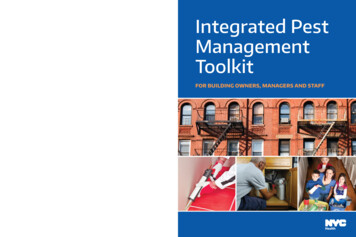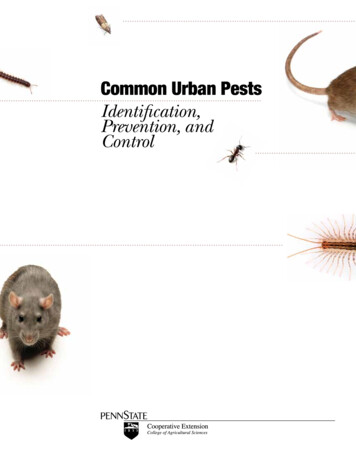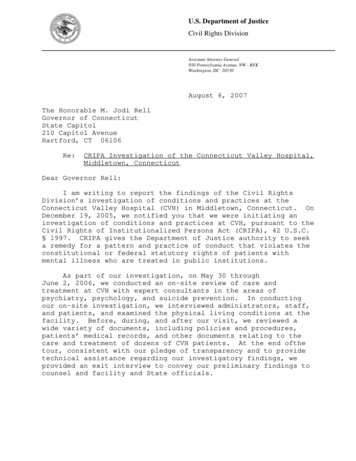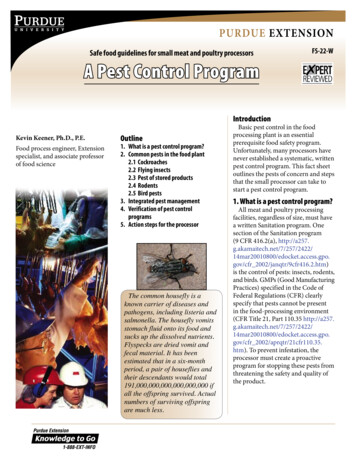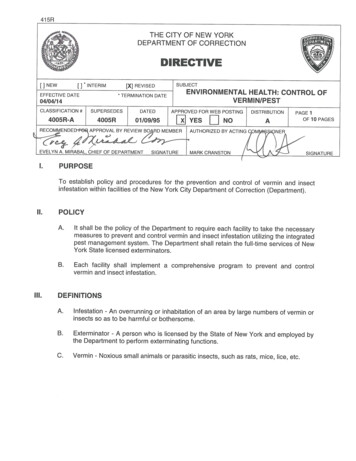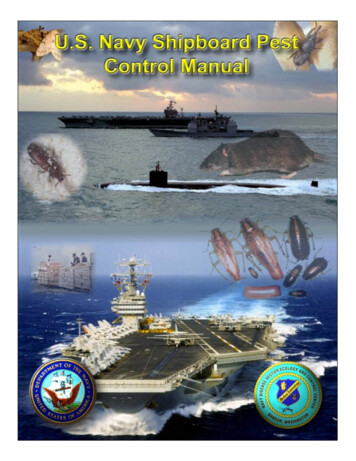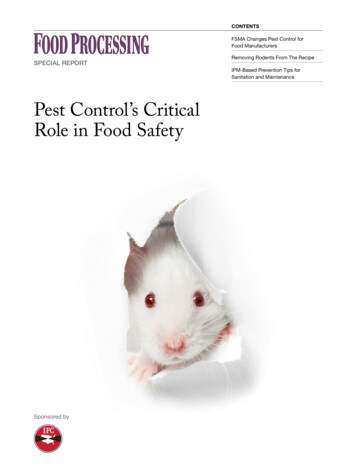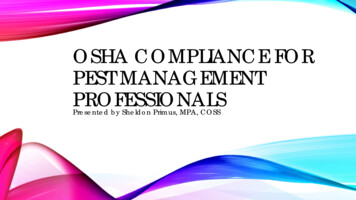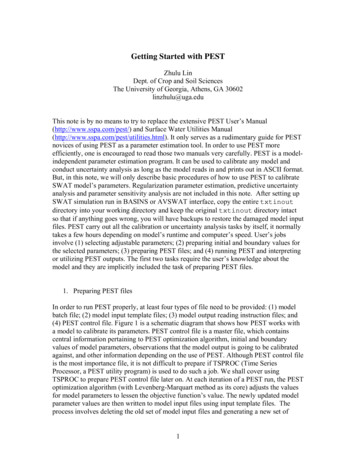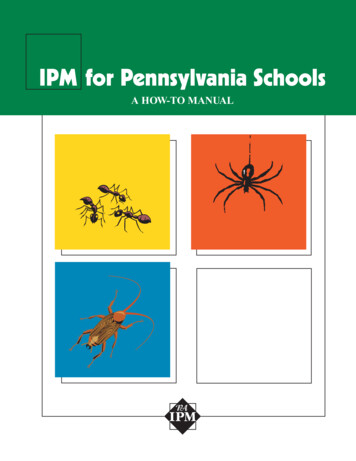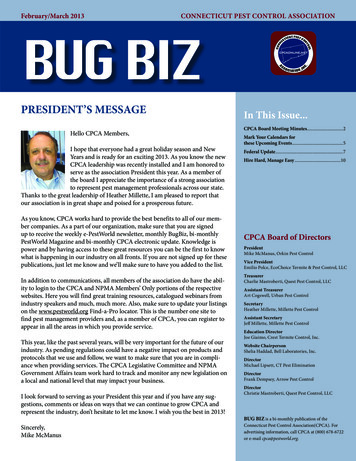
Transcription
CONNECTICUT PEST CONTROL ASSOCIATIONECTI CUT PES T CONTLCORONNFebruary/March 2013ASSPRESIDENT’S MESSAGEHello CPCA Members,I hope that everyone had a great holiday season and NewYears and is ready for an exciting 2013. As you know the newCPCA leadership was recently installed and I am honored toserve as the association President this year. As a member ofthe board I appreciate the importance of a strong associationto represent pest management professionals across our state.Thanks to the great leadership of Heather Millette, I am pleased to report thatour association is in great shape and poised for a prosperous future.As you know, CPCA works hard to provide the best benefits to all of our member companies. As a part of our organization, make sure that you are signedup to receive the weekly e-PestWorld newsletter, monthly BugBiz, bi-monthlyPestWorld Magazine and bi-monthly CPCA electronic update. Knowledge ispower and by having access to these great resources you can be the first to knowwhat is happening in our industry on all fronts. If you are not signed up for thesepublications, just let me know and we’ll make sure to have you added to the list.In addition to communications, all members of the association do have the ability to login to the CPCA and NPMA Members’ Only portions of the respectivewebsites. Here you will find great training resources, catalogued webinars fromindustry speakers and much, much more. Also, make sure to update your listingson the www.pestworld.org Find-a-Pro locator. This is the number one site tofind pest management providers and, as a member of CPCA, you can register toappear in all the areas in which you provide service.This year, like the past several years, will be very important for the future of ourindustry. As pending regulations could have a negative impact on products andprotocols that we use and follow, we want to make sure that you are in compliance when providing services. The CPCA Legislative Committee and NPMAGovernment Affairs team work hard to track and monitor any new legislation ona local and national level that may impact your business.I look forward to serving as your President this year and if you have any suggestions, comments or ideas on ways that we can continue to grow CPCA andrepresent the industry, don’t hesitate to let me know. I wish you the best in 2013!Sincerely,Mike McManusOCIAT I O N ,C.cpcaonline.netINIn This Issue.CPCA Board Meeting Minutes.2Mark Your Calendars forthese Upcoming Events.5Federal Update.7Hire Hard, Manage Easy.10CPCA Board of DirectorsPresidentMike McManus, Orkin Pest ControlVice PresidentEmilio Polce, EcoChoice Termite & Pest Control, LLCTreasurerCharlie Mastroberti, Quest Pest Control, LLCAssistant TreasurerArt Cogswell, Urban Pest ControlSecretaryHeather Millette, Millette Pest ControlAssistant SecretaryJeff Millette, Millette Pest ControlEducation DirectorJoe Giaimo, Crest Termite Control, Inc.Website ChairpersonShelia Haddad, Bell Laboratories, Inc.DirectorMichael Lipsett, CT Pest EliminationDirectorFrank Dempsey, Arrow Pest ControlDirectorChristie Mastroberti, Quest Pest Control, LLCBUG BIZ is a bi-monthly publication of theConnecticut Pest Control Association(CPCA). Foradvertising information, call CPCA at (800) 678-6722or e-mail cpca@pestworld.org.
CPCA Board Meeting MinutesDecember 18th, 2012In attendance were Heather Millette, Art Cogswell, Sheila Haddad, MikeLippset, Jeff Millette, Charlie Mastroberti, Joe Giaimo, and Frank Dempsey.A call to order was made at 5:05 pm. Minutes were read by Jeff Millettefrom the November Meeting. Mike Lippset motioned and Art seconded andthe minutes were accepted as read.Treasurer’s Reports: Art reported that our locally held account had abeginning balance of 24,214.51. There were no deposits and 1,265.10 inexpenses, leaving a balance of 22,949.41.As for our NPMA account we have a beginning balance of 32,469.55.A deposit of 965.00 brings our balance to 33,434.55, which brings us toour total holdings of 56,383.96.There was discussion about a line item in the report for Current Liabilitiesin the amount of 955.45. It was not resolved. Art was going to find outwhat it was for to present at the next meeting in Jan. Mike Lippset made amotion to accept the Treasurer’s Report as read, and Charlie Mastrobertiseconded and the report was accepted.Membership: The Train-a-Tech meeting for Feb 19th was approved by theBoard to be at held at the 4 Point Sheraton in Meriden with Kevin Moranas speaker. Joe will work on a speaker for the March Train-a-Tech. The dateand location needs to be decided.Website: Shelia will have Andy update the new slate of board members andhave the Feb 19th Train-a-Tech posted to the site.The fall seminar was discussed by the Board. The event will be heldTuesday, September 17, 2013 at the Crown Plaza in Cromwell. Emilio Polcehas the paperwork and was unable to attend the meeting.Art Cogswell and Charlie Mastroberti talked about getting together beforethe January 2013 meeting to transfer the treasurer’s books and help CharlieMastroberti get up to speed for 2013.Meeting was adjourned at 5:40 pm.Our next meeting will be on Jan 15th 2013 at 5:00 pm at Lido’s in Meriden.Respectfully submitted,Jeff MilletteSitting in as Secretary for Dec. Meeting2We Want to Hearfrom You!We are always looking forfun and interesting articlesto include in the Bug Bizand would love to hearfrom members about theirexperiences out in thefield. Bug Biz welcomescontributions frommembers. If you wouldlike to contribute, pleasesubmit articles typewrittenby mail or e-mail to thecontact informationlisted below. Photosshould be submitted viae-mail. Be sure to includeyour name and identifyall people shown in thephoto. Deadline forsubmissions is the 10th ofeach month. The editorreserves the right to editall submissions for lengthand content. The Bug Bizis a bi-monthly publicationby the Connecticut PestManagement Association(CPCA). Views andopinions expressed ineditorial articles are notofficial expressions of theCPCA unless so stated.Send advertising andeditorial inquiries to:CPCA Bug Biz10460 North StreetFairfax, VA 22030P: (800) 678-6722cpca@pestworld.orgFebruary/March 2013
FinalSoft BaitJust Reached AWholeNew LevelFINALSOFT BAIT WITH LUMITRACK PATENT PENDINGMore Than Meets The Eyewww.belllabs.com I Madison, WI 53704 USA
Family Owned and OperatedFamily Owned and OperatedGeneralFamilyOwnedLiabilityand ellaLiabilityGeneral LiabilityUmbrella lPropertyUmbrellaLiabilityWorker’s ker’s CompCommercialPropertyWorker’sComp specialistsThe pest controlinsuranceThe pest control insurance specialistsThe pest control insurance specialistsThe pest control insurance specialistsSERVICEOUR#1PRIORITYThe pest IScontrolinsuranceSERVICEISOUR#1 specialistsPRIORITYSERVICE IS OUR #1 PRIORITYSERVICEOUR#1 PRIORITYVisit ourISwebsiteat www.selectagency.comVisit our website at www.selectagency.comSERVICEOUR#1 PRIORITYVisit ourISwebsiteat www.selectagency.comVisit our website at www.selectagency.comquotes@selectagency.com Tel: 888-542-9002 Fax: 866-395-0200quotes@selectagency.com Tel: 888-542-9002 Fax: 866-395-0200Visit our websiteat -542-9002 Fax: 866-395-0200quotes@selectagency.com Tel: 888-542-9002 Fax: 866-395-0200quotes@selectagency.com Tel: 888-542-9002 Fax: 866-395-0200Your Partner inPest Management.At Univar Environmental Sciences, our mission is to helpyou protect your customers’ environments with responsiblepest control solutions. Our trusted professionals, innovativetechnology, comprehensive product selection and vitaleducational resources make us your one source for pestmanagement success.Univar services your entire state. Please contact us at(800) 888-4897 or go to PestWeb.com.One Source. Countless Resources. 2013. Univar USA Inc. All rights reserved. UNIVAR, the hexagon, and other identified trademarks are the property ofUnivar Inc., Univar USA Inc. or affiliated companies.
Mark Your Calendars for These Upcoming Events:Join NPMA March 17-19 for Legislative Day 2013, a yearly event designed to increase the awareness of the keylegislative and regulatory issues impacting the pest management industry.Why Attend Legislative Day?NPMA has a once-in-a-blue-moon opportunity to forge relationships with tomorrow’s leaders today, and thateffort kicks into high gear at NPMA Legislative Day 2013. More than ever, we need you to attend and participate inNPMA Legislative Day and help NPMA establish partnerships with a new generation of federal lawmakers, whichwill ultimately benefit the entire professional pest management industry.Don’t miss out on this year’s keynotes: Laura Ingraham - American radio host, best-selling author, and conservative political commentator U.S. Rep. Paul Ryan (R-WI) - 2012 Republican Vice-Presidential Nominee & Chairman of theHouse Budget Committee Chuck Todd - Chief White House Correspondent for NBC NewsRegister today at www.npmapestworld.org!Academy 2013July 17 – 19Sheraton Wild Horse PassPhoenix, ArizonaPestWorld 2013October 22- 25Phoenix Convention Center / Sheraton Phoenix HotelPhoenix, ArizonaFor more information on these events, visit www.npmapestworld.org.www.cpcaonline.net5
need to get rid of uninvited guests?don’t let the BED BUGS bite!Easy, Effective, ActiveGuard .Kills Bed Bugs Dead!ActiveGuard mattress liners kill bed bugs deadagainst a variety of resistant strains of bed bugs.within 72 hours, making them a vital tool as part ofActiveGuard delivers confidence and security backedany bed bug treatment and control strategy. Unlikeby years of lab and field bed bug testing by researchencasements, ActiveGuard mattress liners are thin,entomologists. Be proactive and use ActiveGuardcomfortable liners that are odorless - and they workmattress liners – They Kill Bed Bugs Dead!Allergy Technologies LLC 866.978.6288 www.allergytechnologies.comPest Management Hotels & Motels Single & Multiple Unit Dwellings Universities Transient Shelters Cruise Lines
Federal UpdateBy Gene Harrington & Bob Rosenberg, NPMAThis article is provided as a member service for National Pest Management Association members. NPMA representsPMPs in federal, state and local legislative and regulatory matters. For more information about the following stories,please contact NPMA at (703) 352-6762 or visit www.npmapestworld.org/publicpolicy.EPA Agrees to Proposed Pyrethroid LabelingLanguageIn 2009, the U.S. Environmental Protection Agencydecided to limit the outdoor non-agricultural use ofpyrethroids, because of potential impacts on aquaticspecies. The new labels began showing up in early2012.Among other things, the label language largelylimited the outdoor use of pyrethroids to crack andcrevice and spot treatments. NPMA, along with theAssociation of Structural Pest Control RegulatoryOfficials, an organization representing state pesticideregulators, and the State FIFRA Issues Research andEvaluation Group, an EPA advisory committee alsocomprised of state regulators, recommended to EPAthat the labels be further changed.NPMA was recently advised that EPA has agreedto language proposed by the groups late last year.The new language will allow PMPs to make outdoorapplications beyond applications to cracks and crevices and spot treatments, provided the application ismade through the use of a coarse, low pressure sprayover a treatable surface (bare soil, lawn, turf, mulchor other vegetation) and not an impervious surfacelike a driveway or sidewalk.The language should begin showing up on labels bythe middle of this year.Update on Endangered Species Act LitigationThe U.S. Environmental Protection Agency recentlymoved for the dismissal of a lawsuit alleging that theAgency’s registration of more than 380 pesticidesviolated the Endangered Species Act (ESA).www.cpcaonline.netUnder ESA all federal agencies that take an actionthat could adversely impact endangered species ortheir habitats are required to consult with the twoagencies charged with administering the ESA – theDepartment of Interior’s U.S. Fish and WildlifeService and the Department of Commerce’s NationalMarine Fisheries Service.While EPA takes into account the possible impacta pesticide may have on endangered and nonendangered wildlife during the pesticide registration process, the Agency had not consulted with theServices prior to the early 2000s. Sensing that theycould exploit this oversight and possibly underminethe entire federal pesticide registration process, activist groups began filing ESA suits in federal courts inthe Pacific Northwest seeking to revoke registrationsor severely limit pesticide use until EPA completedthe ESA required consultations. After sufferingdecisive losses in such litigation, EPA changed tacticsand stopped contest the cases as aggressively. (In aCalifornia suit, significant limitations were placedon PMP uses of many products in a large part of thestate.) Instead, the Agency began to look to resolvethe ESA lawsuits through negotiated settlements withthe activist groups.Armed with an effective and seemingly foolprooflegal strategy, the activist group Center for Biological Diversity in January of 2011 filed the so-called“Mega-Suit,” a case covering 49 states and seekingto cancel registrations or curb use patterns for 382pesticides, including rodenticides, termiticides andmany other pesticides PMPs use on a daily basis.Like in many of the previous cases, EPA officialsand CBD representatives met for more than a year7
in hopes of reaching a settlement. The time frameallocated for negotiations expired in late Octoberand shortly thereafter EPA and numerous industrygroups filed a motion to have the case dismissed.Recognizing the significance of the “Mega-Suit,”NPMA retained legal counsel to track the case and, ifnecessary, file briefs on behalf of the professional pestmanagement industry. NPMA expects significantdevelopments in the “Mega-Suit” and the entire ESAissue in 2013 and will continue to closely monitorthis very important matter.EPA Looks to Establish Efficacy Requirementsfor Certain Pesticide ProductsThe U.S. Environmental Protection Agency plansto convene a panel of scientists and other experts toconsider various issues EPA is contemplating as itdevelops product performance data requirements forthree categories of invertebrate pests. The FederalInsecticide, Fungicide, and Rodenticide Act ScientificAdvisory Panel (FIFRA SAP) will meet on March19-21 in Arlington, VA, to consider and reviewScientific Issues Concerning the Draft ProductPerformance Data Needs Assessment for ProductsClaiming Efficacy Against Invertebrate Pests. (Inmid-January, NPMA nominated a slate of leadingresearchers and industry members to serve on theFIFRA SAP.)According to the Agency: “Recent developmentsin vector-borne diseases, such as the spread of theWest Nile virus, outbreaks of dengue in Florida, andepidemic Rocky Mountain spotted fever on IndianLands, together with the re-emergence of bed bugsin public housing and multifamily dwellings, havesignaled the need to assess more carefully the threatof invertebrate pests to public health.” EPA is alsoconcerned about the economic problems caused bywood-destroying insects such as the Emerald AshBorer and the Asian long-horned beetle.The Agency hopes the product performance datarequirements will give the regulated communitya “better understanding” of what type of data will8be required to support pesticides registrations forthree categories of pests: (1) insects of significantpublic health importance, such as ticks, bed bugs andmosquitoes; (2) wood-destroying insects consideredto be of significant economic importance; and (3)invasive invertebrate species considered to be ofeconomic importance.EPA Seeks to Clarify Minimum Risk PesticideExemptionThe U.S. Environmental Protection Agency(EPA) recently proposed a rulemaking clarifyingthe conditions of exemption for minimum riskpesticides. EPA created the exemption for minimumrisk pesticides to eliminate the need to expendsignificant resources to regulate products that weredeemed to be of minimum risk to human healthand the environment. The existing exemptionhas, however, led to much confusion as to whichingredients are exempt and how they should belabeled on products.Under the rulemaking, EPA is proposing to moreclearly describe the active and inert ingredientspermitted in products eligible for the exemptionfrom regulation for minimum risk pesticides.Specifically, EPA is seeking to reorganize the lists ofexempt active and inert ingredients with a focus onclarity and transparency by adding specific chemicalidentifiers. The identifiers would make it clearerwhich ingredients are permitted in minimum riskpesticide products. EPA is also proposing to modifythe label requirements in the exemption to requirethe use of specific common chemical names in listsof ingredients on minimum risk pesticide productlabels, and to require producer contact informationon the label.NPMA has lobbied EPA to establish efficacyrequirements for minimum risk pesticides label foror claiming to manage bed bugs and other publichealth pests and, while the proposed rulemakingdoesn’t go that far, NPMA is encouraged by thisdevelopment.February/March 2013
EPA Seeks Comment on Draft PR Notice onWeb-Distributed LabelingThe U.S. Environmental Protection Agency recentlyissued and solicited comment on a draft PesticideRegistration (PR) Notice entitled “Web-DistributedLabeling for Pesticide Products.” The draft PR Noticeprovides “guidance concerning the process by whichregistrants can make legally valid versions of pesticide labeling available through the Internet.”According to EPA, web-distributed labeling (WDL)would allow users to retrieve a streamlined version ofthe pesticide product labeling, which would includedirections for use and necessary information relatedto the user’s specific state and intended site of use.EPA notes that shorter, relevant labeling “could beclearer and easier for the user to understand, improving compliance with pesticide labeling requirementsand thereby protecting human health and the environment from unintentional misuse of pesticides.Web-distributed labeling would also allow for morerapid updates to pesticide labeling, meaning riskmitigation measures and new uses can reach theuser more quickly than under the current paperbased system.” Comments on the PR Notice are dueApril 16, 2013.U.S. Small Business Administration IncreasesSmall Business Size Standard for Pest ControlService IndustryThe U.S. Small Business Administration recentlyincreased the small business size standard for thepest control service industry from 7 million to 10million. Small business size standards determineeligibility for small business assistance and for federalcontracts set aside for small business.The move is part of a larger rulemaking initiativeincreasing the small business size standards for 37industries in North American Industry ClassificationSystem (NAICS) Sector 56, Administrative and Support, Waste Management and Remediation Services.(The NAICS number for Exterminating and PestControl Services industry is 561710.) The revisedsize standards went into effect on January 7, 2013.www.cpcaonline.netNPMA Member Reappointed to USDA AdvisoryCommitteeNPMA member Scott Steckel of Varment GuardEnvironmental Services in Columbus, OH wasrecently reappointed to the National Wildlife ServicesAdvisory Committee (NWSAC). The panel advisesthe U.S. Department of Agriculture on the activitiesand policies of Wildlife Services (WS) and it servesas a public forum that enables those affected by theWS program to have a voice in the program’s policies.NWSAC has served as a good opportunity for Scottto raise awareness of WS unfairly competing withthe private sector for various rodent, nuisance birdand wildlife work the professional pest managementindustry has the capability and capacity to perform.This will be Scott’s third term on NWSAC. Russ Ivesof Rose Pest Solutions in Troy, MI and Gene Chafeof Senske Pest Control in Kennewick, WA previouslyrepresented NPMA on the panel.US Labor Department Sues Ohio RetirementFacility Seeking Reinstatement, Back Wages forWhistleblower Who Reported Bedbugs at Retirement HomeThe U.S. Department of Labor has filed a lawsuit infederal court against an Ohio retirement facility forviolating the whistleblower provisions of the Occupational Safety and Health Act of 1970. The facilityterminated a resident manager for filing a complaintwith local health district stating that the facility hadbeen ineffective in handling a bedbug infestation atthe retirement home.The manager was dismissed Oct. 5, 2011. The suitseeks reinstatement of the worker, in addition to anundetermined amount of back wages and benefits,and the removal of all derogatory information relatedto the dismissal from the worker’s employmentrecord. The suit also seeks to permanently enjoin theemployer from violating the OSH Act in the futureand require that a notice be posted for employeesregarding their rights under the act.9
Hire Hard, Manage EasyBy Jean L. Seawright, CMCLet’s face it—you can’t do it on your own. No matterhow much energy or talent you possess, after acertain point, in order to grow your business or yourdepartment, you need people. And, it’s impossibleto manage people effectively without first hiringeffectively. I know you’ve heard a lot about hiringlately, but read on. This one is worth it.Throughout my consulting career I have continuallychallenged the popular notion that “a company’sgreatest assets are its employees.” Whenever I see thisslogan, I remind the owner that people, in general,are not a company’s greatest asset; however, theright people are. The fact is, ultimately, the successor failure of a business or department hinges onmanagement’s ability (or inability) to recruit, hire,and retain talent.You’ll notice that this list of three skills begins withrecruiting. Why? Because you can’t hire talent ifyou can’t first attract it to your business. So the firststep in smart hiring is always to effectively sell yourcompany and your position to the right audience—one with talent. Unfortunately, many employersforgo a thoughtful recruiting process in lieu of atwo-line on Craig’s List. Then, when they’re lookingat a less-than-ideal pool of applicants, they complainthat there “just aren’t any good candidates outthere” and they proceed to hire the best of the worst.Mistake! Effective recruiting is the key to attractingtalent so invest the time up front to attract qualifiedcandidates to your business.Now, in the world of human resources we have amotto that’s an off-shoot of the well-known phrasecoined by nutritionalists, “You are what you eat.”In HR we say, “You are who you hire.” True, isn’tit? Assuming you agree, it stands to reason that ifyou hire employees from hell, you will soon have aworkplace from hell. What a concept! It’s better to hiresmart and avoid people in red suits with horns.10Once you have talent lined up at your door, you musthave an effective process for identifying the needlein the haystack—that is, selecting the candidate whopossesses the traits necessary for success in the job.Problem is, many employers don’t take the time tospecifically identify these traits—they would rather“wing it” in the interview and follow their “gut.” Withall the risk in hiring today, following your “gut” canlead to significant liabilities or even financial ruin.A better strategy is to take time to identify the traitsin a person that are essential to success on the job.I recommend that you do this before writing yourclassified ad so you can use verbiage that attracts the“right” person. Then, develop interview questions tohelp determine the extent to which these traits existin candidates.As you think about the ideal candidate, don’t makethe mistake of overlooking basic traits that areessential for success in almost any position. Thesetraits go beyond experience and previous workhistory, and have become increasingly important asthe workforce makeup has changed. Take a look:Work ethic. Work ethic is not something that comeswith a long employment history. What we’ve foundis that work ethic is developed at a very early ageand has more to do with feelings about work thatare formed in childhood. To gauge whether or notthe candidate has a strong work ethic, talk with thecandidate about how his or her parents felt aboutworking. Did Dad or Mom always walk through thedoor at the end of the day and complain about theboss or the job? Or, did they proudly speak of theirwork and the value it brought to the communityor home life? Answers to these questions will helpyou determine if the candidate views work as theenemy or not! Loyalty. Does the candidate have anychildhood friends? Is there evidence of longterm relationships that require loyalty?February/March 2013
Sense of humor. This is not the ability totell a joke, but the ability to go through life’sups and downs and still keep a smile on yourface. It’s the concept of seeing the glass “halffull” instead of “half-empty.” Talking with thecandidate about his her life and the differentchallenges he or she faced will give you cluesabout this one. Respect. One of the best tests of respect ishow the candidate treated the receptionist.Some companies have the receptionistcomplete a form after meeting the candidatethat zeros in on things like how easily thecandidate smiled and whether or not thecandidate was polite and easy to talk with. Judgment. There’s no replacement for anemployee who exercises good judgment indecision-making. This one relates to commonsense. Ask the candidate to give you examplesof using his or her independent judgment andthoughts in making important decisions. Flexibility. A person who opposes change canhave difficulty growing with the company.Look for clues in the candidate’s life andpersonal development—evidence that he orshe has been open to change, both personallyand professionally. Integrity. The credibility of your companyis at stake with every new hire. Only hirepeople with complete integrity. Crosscheckinformation from the employment application,resume, reference checks, and the interview.Conduct background checks to minimize riskand verify integrity. Maturity. Contrary to popular belief, maturitydoes not necessarily come with age! Again,spending ample time with the candidate talkingabout his or her past will give insight into thematurity level. Also, it has been said that maturityis the ability to delay self-gratification. If this istrue, look for signs that the candidate has notgiven into every whim and fancy in his or her life.www.cpcaonline.net Dependability. This can be verified throughreference checking and talking with formeremployees about the individual’s dependability. Aptitude. It’s no secret that aptitude does notnecessarily come from a formal education. Youcan get a general idea of “stretch potential” andthe ability to learn using formalized aptitudetests. Initiative. This one is very difficult to assessduring the interview, but easy to pick up onshortly after hire. Ask reference sources aboutinitiative and look for signs within the first 90days of hire. If you don’t see initiative then, it’snot likely to develop. Enthusiasm. Only hire people who believe inyour company mission and philosophy. Oneway to gauge genuine interest and enthusiasm(aside from conversation during the interview)is to give the candidate a tour. It’s one thing tosay you’re interested in and excited about a job.It’s another thing to show it.The extent to which these traits exist can beidentified through personality profiles, properquestioning and, perhaps most importantly, qualitytime with the candidate. There are no shortcutsto a smart hire decision. Proper interviewing andhiring take time and the more time you invest withthe candidate (and it is, indeed, an investment), thebetter prepared you will be to make a wise choice.Bottom line: Hire hard, then you can manage easy.Of course this works in the reverse—you can hireeasy and then you will manage hard. The choice isyours!Jean Seawright is president of Seawright & Associates, an HRmanagement consulting firm located in Winter Park, Florida. Since1987, she has provided human resource management and complianceadvice to employers across the country. She can be contacted at407-645-2433 or jseawright@seawright.com.11
CO CCOCONNONNNNNNLLOLLROLRORRORONTNNTT NTNTUT PEST CTICOECUT PEST CTICOEC CUT PESTcpcaonline.netCOTIECCONNIATIONC.AT PESTcpcaonline.netICUCOCTSEScpcaonline.netOC, INSSSSC. CC.AA ASScpcaonline.netOCN, I NIATIONINO CIATION,O CIINC.AConnecticut Pest Control AssociationConnecticutPest10460North StreetConnecticutPest ControlControl estControlAssociationFairfax,Virginia2203010460 North fax,Virginia22030Fax: 8-6722www.cpcaonline.netFax: (703) 352-3031www.cpcaonline.netFax:(703) TICUTMeMBeRSHIPAPPLICATIONAPPlICATIoNCONNECTICUT CATIONFor NPMAAPPLICATIONand CPCA Joint Membershipfor andJanuary2010through December2010through December 31, 2013CONNECTICUTMEMBERSHIPAPPLICATIONCONNECTICUT MEMBERSHIPFor NPMACPCA1,JointMembershipfor January31,1, 2013Co
Heather Millette, Millette Pest Control Assistant Secretary Je Millette, Millette Pest Control Education Director Joe Giaimo, Crest Termite Control, Inc. Website Chairperson Shelia Haddad, Bell Laboratories, Inc. Director Michael Lipsett, CT Pest Elimination Director Frank Dempsey, Arrow Pest Control Director Christie Mastroberti, Quest Pest .

